The Army Dress Blue Uniform is a formal ceremonial attire symbolizing professionalism and heritage. Comprising a dark-blue coat, matching trousers, white shirt, and black tie, it is worn during significant events, parades, and official ceremonies, representing the U.S. Army’s rich tradition and pride.
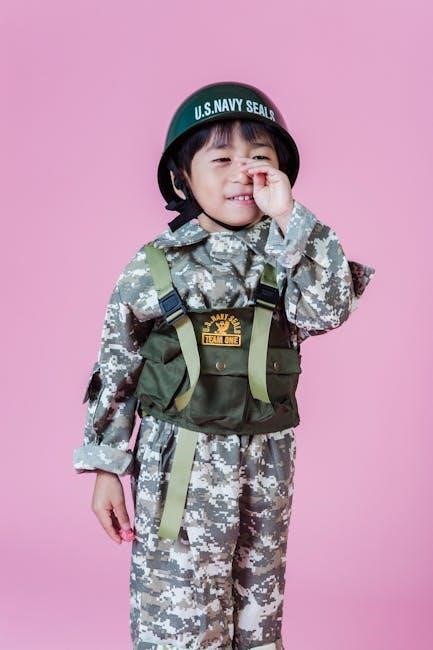
Overview of the Dress Blue Uniform
The Army Dress Blue Uniform is a formal, dark-blue uniform worn for ceremonial and official events. It consists of a coat, trousers, white dress shirt, black necktie or bowtie, and black shoes. The uniform is adorned with medals, ribbons, and insignia, showcasing a soldier’s achievements and service. It is typically worn during parades, memorial services, national holidays, and high-profile ceremonies. The Dress Blue Uniform reflects the Army’s commitment to tradition, professionalism, and discipline. Proper wear and adherence to regulations ensure a sharp, cohesive appearance, honoring the legacy of U.S. Army service. This uniform is a symbol of pride and respect for soldiers and veterans alike.
Significance of the Dress Blue Uniform in the U.S. Army
The Army Dress Blue Uniform holds profound significance as a symbol of professionalism, unity, and tradition within the U.S. Army. It is worn during formal ceremonies, memorials, and parades, representing the Army’s heritage and the sacrifices of its soldiers. The uniform embodies the values of discipline, respect, and service, fostering a sense of pride and camaraderie among soldiers and veterans. It also serves as a visual representation of a soldier’s achievements, with medals, ribbons, and insignia showcasing their dedication and contributions. The Dress Blue Uniform is a timeless emblem of the U.S. Army’s legacy, honoring the past while inspiring future generations to serve with distinction.
When to Wear the Dress Blue Uniform
The Army Dress Blue Uniform is reserved for formal occasions, including national holidays, memorial services, and military ceremonies such as parades, retirements, and change-of-command events. It is also worn during weddings, military balls, and other high-profile functions. Active-duty personnel don the uniform for official events, while veterans may wear it during patriotic ceremonies and commemorative activities. The uniform’s formality dictates its use in situations requiring the highest level of respect and tradition, ensuring its appearance aligns with the dignity of the occasion. Proper wear is guided by AR 670-1, ensuring consistency and adherence to military standards;
Components of the Army Dress Blue Uniform
The Army Dress Blue Uniform consists of a dark-blue coat, matching trousers, white dress shirt, black necktie or bowtie, and black shoes and socks. Accessories include a beret or headgear, with variations for males and females, such as skirts for women. The uniform is meticulously tailored to reflect professionalism and adherence to military standards, ensuring a sharp, cohesive appearance during formal events and ceremonies.
Male Army Dress Blue Uniform Components
The male Army Dress Blue Uniform includes a midnight-blue coat with brass buttons, matching trousers with a stripe, a white dress shirt, and a black necktie or bowtie. Black leather oxfords or dress shoes are required, along with black socks. The uniform also includes a beret or other authorized headgear. Male soldiers wear insignia, badges, and awards on the coat, following specific placement guidelines. The uniform is tailored to fit precisely, ensuring a sharp, professional appearance. All components must comply with Army Regulation 670-1, emphasizing attention to detail and proper alignment of medals, ribbons, and insignia to uphold military tradition and standards.
Female Army Dress Blue Uniform Components
The female Army Dress Blue Uniform consists of a midnight-blue coat with brass buttons, a matching skirt or trousers, and a white blouse. A black necktie or bowtie is required, along with black pumps or dress shoes. The uniform also includes a beret or other authorized headgear. Female soldiers wear insignia, badges, and awards on the coat, adhering to specific placement guidelines. The uniform is tailored for a professional fit, with attention to detail in alignment and placement of medals, ribbons, and insignia. Accessories like jewelry should be minimal and subtle, ensuring the uniform presents a sharp, polished appearance in line with Army standards.
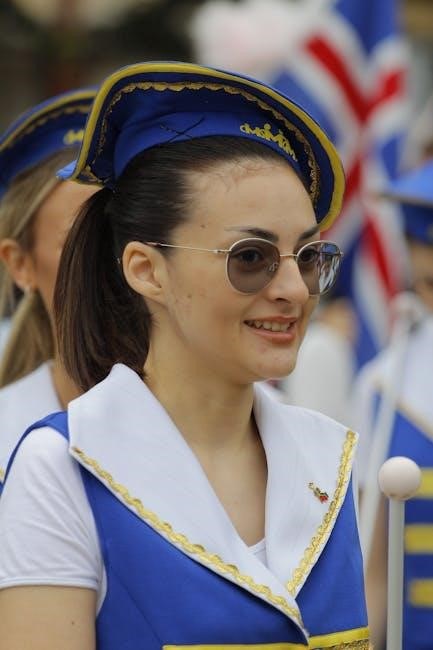
Army Regulation 670-1: Uniform Wear and Appearance
AR 670-1 governs the wear and appearance of Army uniforms, ensuring uniformity and professionalism across all ranks. It covers standards for grooming, insignia, and proper uniform display.
Key Points of AR 670-1
AR 670-1 establishes standards for uniform wear, ensuring discipline and professionalism. It details grooming, insignia placement, and uniform fit. Specific guidelines cover medal and ribbon placement, with precise measurements for alignment and spacing. The regulation also addresses footwear, headgear, and accessory requirements. For the Dress Blue Uniform, it mandates correct positioning of badges, unit awards, and regimental insignia. Compliance is enforced through inspections, ensuring all soldiers meet appearance standards. The regulation applies to all ranks, emphasizing uniformity and respect for tradition. Proper adherence to AR 670-1 reflects the Army’s commitment to maintaining a professional and cohesive image.
Compliance and Inspections
Compliance with AR 670-1 is rigorously enforced through regular inspections, ensuring adherence to uniform standards. Inspections verify proper wear, grooming, and placement of insignia, medals, and ribbons. Leaders conduct checks to maintain uniformity, focusing on fit, cleanliness, and alignment of components. Non-compliance results in corrective actions, emphasizing the importance of meeting standards. Inspections reinforce discipline and professionalism, upholding the Army’s image. Soldiers must ensure all aspects of their uniform align with regulations, reflecting pride and respect for tradition. Proper compliance demonstrates dedication to service and adherence to military protocol, fostering a cohesive and professional force. Inspections are a critical tool in maintaining these high standards.
Medal and Ribbon Placement on the Dress Blue Uniform
Medals and ribbons are placed on the left chest, with full-sized medals centered above the breast pocket. Ribbons are aligned horizontally, following AR 670-1 guidelines precisely.
Full-Sized Medal Placement
Full-sized medals are worn on the left chest of the Army Dress Blue Uniform, centered above the left breast pocket. They are placed in a specific order of precedence, as outlined in AR 670-1, ensuring proper alignment and spacing. Each medal is positioned 1/8 inch apart if multiple medals are worn. The top of the medals should align horizontally, maintaining a neat and uniform appearance. Soldiers must ensure their medals are securely fastened and reflect their military achievements accurately. Proper placement honors the wearer’s service and adheres to the Army’s tradition of meticulous uniform standards.
Ribbon Placement Guidelines
Ribbons on the Army Dress Blue Uniform are placed on the left side of the jacket, centered above the left breast pocket for male soldiers. Female soldiers position ribbons on the left side, aligning the bottom row parallel to the nameplate, adjusting for body shape if necessary. Ribbons are worn in order of precedence, with no overlapping, and spaced 1/8 inch apart. The top row should align horizontally, ensuring a neat and professional appearance. Proper ribbon placement reflects a soldier’s achievements and adheres to the Army’s standards of uniformity and discipline, as outlined in AR 670-1.

Combat and Skill Badge Placement
Combat and Skill Badges are worn on the left side of the Army Dress Blue Uniform. Combat Badges are positioned above the ribbons, centered on the left chest, while Skill Badges are placed below the ribbons. Both types of badges are aligned horizontally, with a 1/8 inch spacing between them if multiple badges are present. Combat Badges take precedence and are situated higher up, ensuring a professional and standardized appearance. Proper placement adheres to Army uniformity standards, as outlined in AR 670-1, maintaining a neat and organized display of a soldier’s achievements.
Marksmanship Badge Placement
Marksmanship Badges are worn below the ribbons on the Army Dress Blue Uniform. They are centered on the left chest, with a 1/8 inch space between badges if multiple marks are present. Only three badges can be worn, with the highest achievement placed on the left. Badges are positioned 1/4 inch above the bottom of the pocket flap. Proper alignment ensures a polished appearance, adhering to AR 670-1 standards. Soldiers earning multiple badges display them in descending order of precedence, reflecting their skill level and contributions. Correct placement emphasizes military tradition and individual excellence.

Badge and Insignia Placement
Badges and insignia on the Army Dress Blue Uniform are positioned to reflect military tradition and personal achievements. Proper placement adheres to AR 670-1 guidelines, ensuring a polished appearance.
Unit Awards Placement
Unit awards on the Army Dress Blue Uniform are placed on the right chest, centered above the right breast pocket. These awards are displayed to recognize collective achievements and unit citations. Soldiers ensure that all awards are securely fastened and aligned properly, maintaining uniformity across the formation. The placement must comply with AR 670-1 guidelines, ensuring correct positioning relative to other insignia. Proper display of unit awards enhances the overall appearance of the uniform, reflecting pride in service and accomplishments. Attention to detail ensures respect for the unit’s history and contributions.
Identification Badge Placement
Identification badges on the Army Dress Blue Uniform are placed on the right side of the jacket. They are centered between the bottom of the right pocket and the bottom of the pocket flap. This placement ensures a neat and professional appearance. Soldiers must ensure badges are securely fastened and properly aligned. Proper placement adheres to AR 670-1 guidelines, maintaining uniformity across all personnel. Identification badges are essential for recognizing individual roles and qualifications, and their correct placement reflects attention to detail and adherence to military standards.
Regimental Insignia Placement
The regimental insignia is worn on the right side of the Army Dress Blue Uniform jacket. It is positioned 1/8 inch above the right breast pocket or 1/4 inch above any unit awards. This placement ensures the insignia is visible and properly aligned. The regimental crest signifies the soldier’s regiment or branch affiliation, adding to the uniform’s ceremonial appearance. Proper placement adheres to AR 670-1 guidelines, maintaining uniformity and tradition. Soldiers must ensure the insignia is securely fastened and centered to reflect professionalism and pride in their unit heritage. Correct placement is essential for a polished and respectful presentation of the uniform.
Distinguished Unit Insignia (DUI Crest) Placement
The Distinguished Unit Insignia (DUI Crest) is placed on the left shoulder loop of the Army Dress Blue Uniform jacket. It is centered between the button and the rank insignia, ensuring proper alignment and visibility. The DUI Crest represents the unit’s history and achievements, making it a crucial element of the uniform. Soldiers must secure the crest firmly to maintain a professional appearance. This placement applies to both enlisted personnel and officers, adhering to the standards outlined in AR 670-1. Correct positioning of the DUI Crest showcases unit pride and contributes to the uniform’s overall ceremonial integrity.
Uniform Accessories
Army Dress Blue Uniform accessories include a black necktie or bowtie, optional beret or headgear for men, and appropriate footwear. These items must comply with AR 670-1 standards.
Necktie and Bowtie Options
For the Army Dress Blue Uniform, men are required to wear a black necktie, while a bowtie is optional for evening events after retreat. Women may also wear a black necktie, though it is not mandatory. The necktie must be made of black silk or satin material, ensuring a polished appearance. Bowties, if worn, should also be black and neatly tied to maintain uniformity. Proper alignment and tightness of the necktie are essential, with the tip reaching the belt buckle. These accessories complement the uniform’s formal aesthetic, adhering to AR 670-1 guidelines for a professional and cohesive look.
Headgear Requirements
The Army Dress Blue Uniform requires the wear of a black beret as standard headgear. The beret must be pulled to the right, with the flash positioned over the left eye. The insignia is centered 1/8 inch above the beret flash. For formal events, headgear is mandatory unless otherwise specified. The beret is the only authorized headgear for the Dress Blue Uniform, ensuring consistency and adherence to AR 670-1 guidelines. Proper fitting and alignment are essential to maintain a sharp, professional appearance. Soldiers are expected to wear the beret correctly during all ceremonial and formal occasions, reflecting the Army’s tradition of discipline and uniformity.
Footwear Standards
The Army Dress Blue Uniform requires black leather oxford shoes, highly polished to a mirror finish. Shoes must be made of genuine leather, with a smooth, unblemished surface. Male soldiers wear the shoes with laces tightly secured, ensuring a sharp, professional appearance. The footwear must complement the uniform, with no visible logos or decorations. For female soldiers, low-heeled black pumps are authorized, with a closed toe and a minimum 1/2-inch heel. Proper fit and polish are essential, as substandard footwear can detract from the uniform’s overall appearance. The shoes must adhere strictly to AR 670-1 guidelines, ensuring uniformity and discipline in all formal settings.
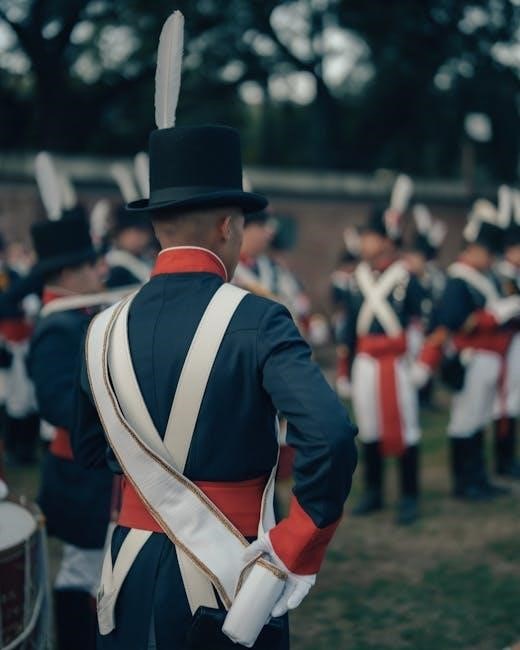
Grooming and Personal Appearance Standards
Adherence to strict grooming standards is crucial. Haircuts must be neat, with no visible stubble, and nails must be clean and trimmed. Facial hair is prohibited for men, while women must maintain conservative hairstyles. Uniforms must fit perfectly, emphasizing professionalism and discipline. These standards, outlined in AR 670-1, ensure a polished image, reflecting the Army’s values and tradition.
Hairstyles and Grooming for Male Soldiers
Male soldiers must maintain neat, clean hairstyles that align with Army standards. Haircuts should be no longer than 1/4 inch on the sides and back, with a defined edge. No visible stubble is permitted, and shaving is mandatory unless a medical waiver is granted. Sideburns must not extend below the ear opening, and mustaches, if worn, must be well-groomed and not extend past the corners of the mouth. Fingernails must be clean and trimmed short. Tattoos on the face or neck are prohibited. Soldiers are expected to present a polished, professional appearance, reflecting the Army’s standards of discipline and pride.
Hairstyles and Grooming for Female Soldiers
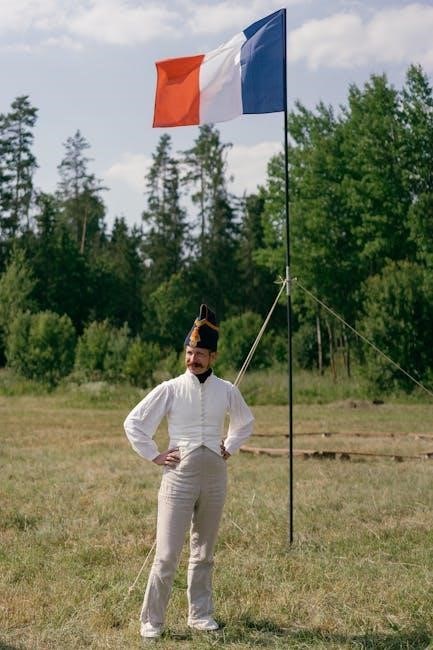
Female soldiers must adhere to specific grooming standards while wearing the Army Dress Blue Uniform. Hair must be styled neatly, kept off the collar, and above the shoulder line when in uniform. Styles should be conservative, avoiding exaggerated or bulky designs. Hair color must be natural and conservative, avoiding bold or bright hues. Jewelry is limited to simple earrings and a wedding band, with no visible body piercings. Fingernails must be clean, trimmed short, and free of excessive polish. Makeup, if worn, should be subtle and understated. The overall appearance must reflect professionalism, discipline, and alignment with Army grooming standards.

Occasions for Wearing the Dress Blue Uniform
The Army Dress Blue Uniform is worn during formal ceremonies, parades, national holidays, weddings, and memorial services, honoring military traditions and showcasing professionalism for both active duty and veterans.

Active Duty Ceremonial Events
Active duty soldiers wear the Army Dress Blue Uniform during high-profile ceremonies, such as change-of-command events, promotion and awards ceremonies, and military balls. These events emphasize military tradition and discipline, requiring precise adherence to uniform standards. The uniform’s formal appearance reflects the soldier’s commitment to service and professionalism. Ceremonial parades and inspections also necessitate the Dress Blues, showcasing unity and pride among troops. Proper medal and ribbon placement, along with meticulous grooming, are critical to maintaining the uniform’s polished image. Such events highlight the uniform’s role in representing the U.S. Army’s legacy and values.
Veteran and Retirement Events
Veterans and retirees often wear the Army Dress Blue Uniform during significant events like Memorial Day and Veterans Day ceremonies, retirement ceremonies, and military reunions. This uniform serves as a symbol of their service and achievements, allowing them to honor their legacy. Veterans may also choose to wear their Dress Blues for funerals or special occasions tied to military tradition. The uniform must adhere to current regulations, with proper placement of medals, ribbons, and insignia. For retirees, the Dress Blues are a poignant way to reflect on their career and connect with fellow service members. It is also an option for veterans to be buried in their Dress Blues, symbolizing enduring pride in their service.
Maintenance and Storage of the Dress Blue Uniform
Regular cleaning and proper storage are essential to preserve the uniform’s quality. Store in a cool, dry place, avoiding direct sunlight, and use padded hangers to maintain shape.
Proper Cleaning and Care
Proper cleaning and care are crucial to maintain the integrity and appearance of the Army Dress Blue Uniform. The dark blue coat and trousers should be dry-cleaned by a professional familiar with military uniforms, while the white dress shirt can be hand-washed using mild detergent. Avoid machine washing or bleaching to prevent damage. Store the uniform in a cool, dry place, away from direct sunlight, to prevent fading. Use padded hangers to maintain the shape of the coat and trousers. For extended storage, consider using breathable garment bags to protect against dust and moisture. Regular inspections ensure all components remain in excellent condition.
Storage Tips to Maintain Uniform Quality
To preserve the Army Dress Blue Uniform’s condition, store it in a cool, dry environment away from direct sunlight. Use breathable garment bags or acid-free boxes to protect against dust and moisture. Cedar blocks or mothballs can prevent pests. Hang the coat and trousers on padded hangers to maintain their shape. Store the white dress shirt and accessories in separate, clean containers to avoid creasing. Ensure all items are clean and dry before storage to prevent mildew. Regularly inspect stored uniforms for signs of damage or wear. Proper storage ensures the uniform remains sharp and ready for future ceremonial events, upholding its professional appearance and heritage.
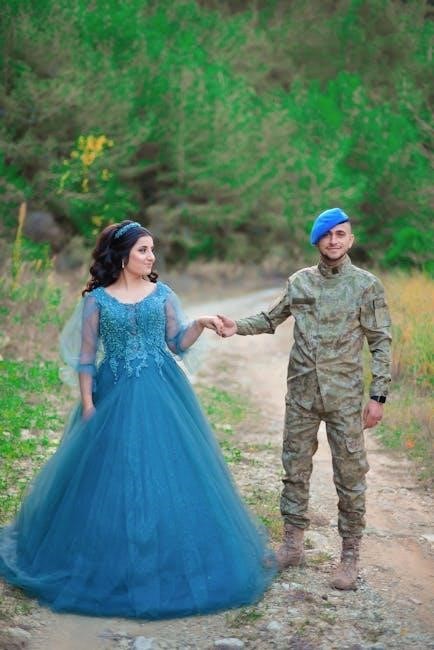
Common Mistakes to Avoid
Common errors include incorrect medal and ribbon placement, loose stitching, and improper grooming. Ensure compliance with AR 670-1 and conduct regular inspections to maintain professionalism and uniformity.
Incorrect Medal and Ribbon Placement
Incorrect medal and ribbon placement is a frequent mistake that undermines uniformity and professionalism. Medals must be centered above the left breast pocket, while ribbons are placed 1/8 inch above the left pocket for males and adjusted for females. Combat and skill badges should be worn above ribbons or below the pocket, with proper spacing. Marksmanship badges are placed below ribbons, and unit awards are centered above the right pocket. Identification badges are positioned between the right pocket’s bottom and flap. Regimental insignia and DUI crests have specific placement requirements. Always refer to AR 670-1 for precise measurements and alignment to ensure accuracy and respect for military tradition.
Non-Compliance with Grooming Standards
Non-compliance with grooming standards is a significant issue that can lead to disciplinary action. Male soldiers must adhere to strict hair length and facial hair regulations, ensuring neatness and professionalism. Female soldiers must wear hairstyles within specified length and style guidelines, avoiding excessive jewelry or bold makeup. Nails should be clean, trimmed, and free of elaborate designs. Failure to meet these standards undermines uniformity and military discipline. Commanders conduct regular inspections to enforce grooming policies, emphasizing the importance of maintaining a polished appearance. Proper grooming reflects individual and unit pride, aligning with the Army’s tradition of excellence and professionalism. Adherence is non-negotiable for active-duty and veteran personnel alike.
The Army Dress Blue Uniform is a symbol of pride, professionalism, and service, representing the U.S. Army’s rich heritage and tradition. Adhering to AR 670-1 ensures proper wear and appearance, maintaining uniformity and respect for the uniform. Whether worn at ceremonies, parades, or formal events, the Dress Blues reflect a soldier’s dedication and achievements. Veterans often wear this uniform to honor their service and connect with their military legacy. Proper care, maintenance, and adherence to guidelines ensure the uniform remains a timeless representation of military excellence. Wearing the Dress Blues correctly honors the Army’s legacy and the individual’s service, embodying the values of duty, honor, and country.
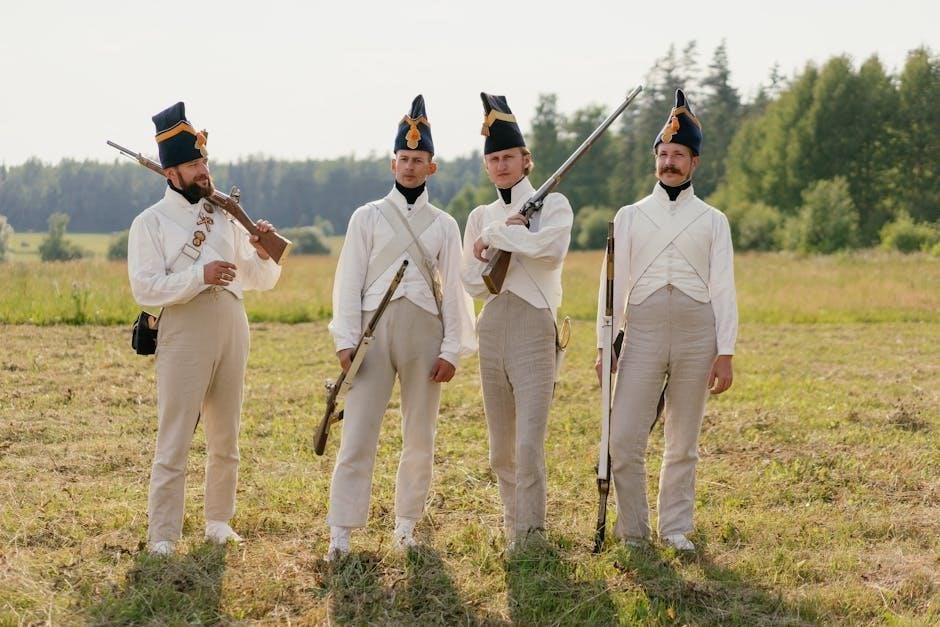
No Responses